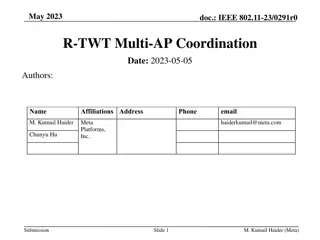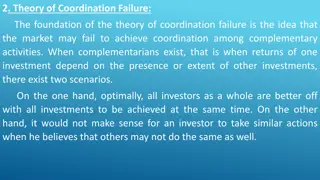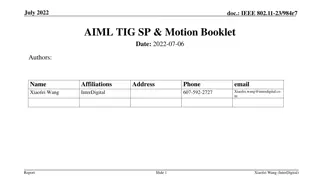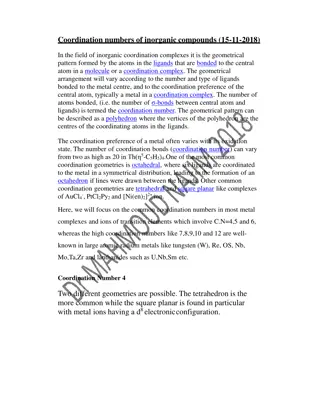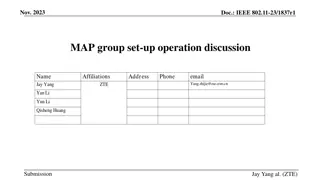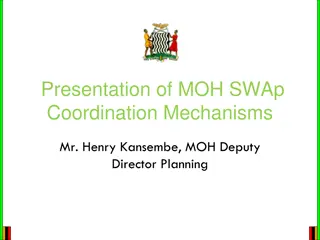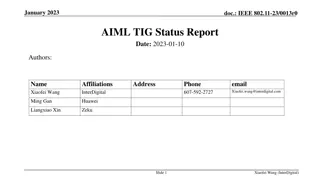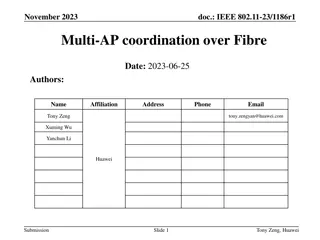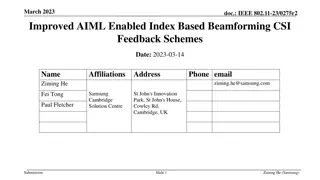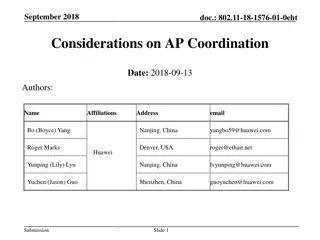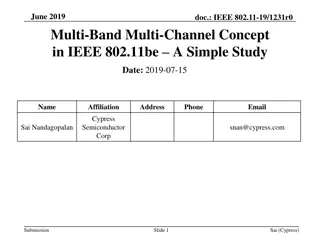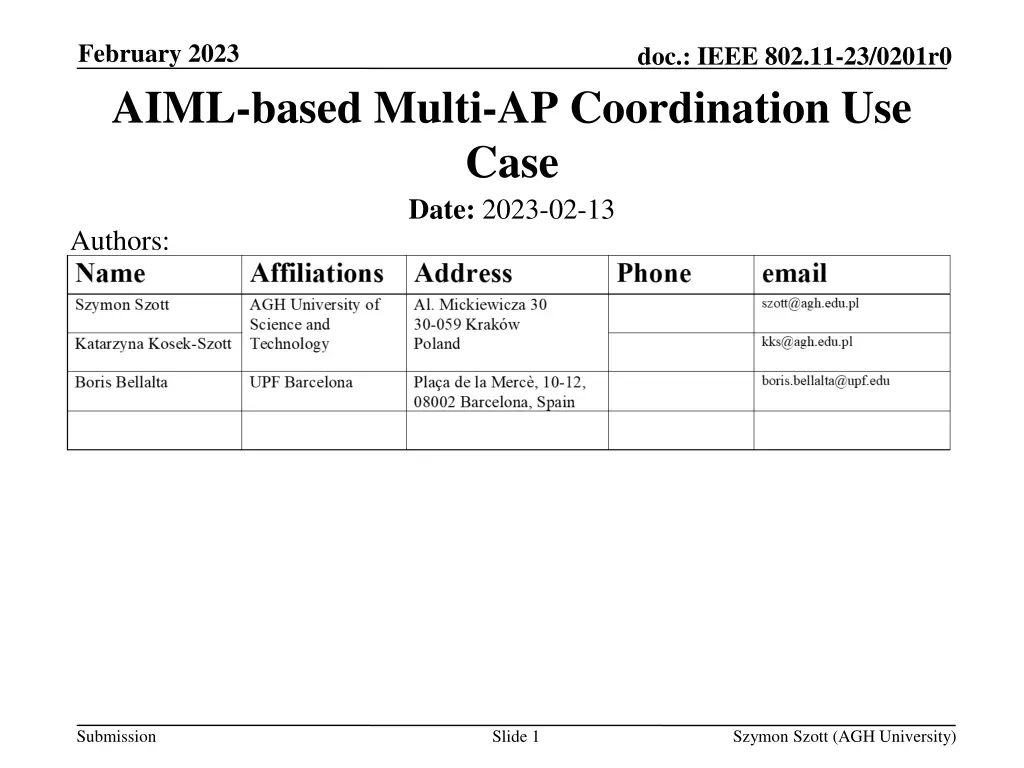
AI-Enabled Multi-AP Coordination for WLAN Optimization
Explore a detailed case study on AI and Machine Learning-based multi-AP coordination for improving resource utilization and minimizing interference in wireless local area networks. The study focuses on utilizing AIML methods at access points to enhance coordination schemes effectively. Various coordination levels and subtypes are discussed, showcasing the potential of AI in advancing WLAN technologies for better performance and efficiency.
Download Presentation

Please find below an Image/Link to download the presentation.
The content on the website is provided AS IS for your information and personal use only. It may not be sold, licensed, or shared on other websites without obtaining consent from the author. If you encounter any issues during the download, it is possible that the publisher has removed the file from their server.
You are allowed to download the files provided on this website for personal or commercial use, subject to the condition that they are used lawfully. All files are the property of their respective owners.
The content on the website is provided AS IS for your information and personal use only. It may not be sold, licensed, or shared on other websites without obtaining consent from the author.
E N D
Presentation Transcript
February 2023 AIML-based Multi-AP Coordination Use Case Date: 2023-02-13 Authors: doc.: IEEE 802.11-23/0201r0 Submission Slide 1 Szymon Szott (AGH University)
February 2023 doc.: IEEE 802.11-23/0201r0 Abstract Outline of a proposed use case (for the AIML TIG technical report) focusing on ML-based multi-AP coordination (MAPC). Submission Slide 2 Szymon Szott (AGH University)
February 2023 doc.: IEEE 802.11-23/0201r0 Use Case Goal This use case proposes to apply AIML methods (deployed at APs) to multi-AP coordination schemes to improve utilization of available resources while maintaining minimum inter-cell interference. Submission Slide 3 Szymon Szott (AGH University)
February 2023 doc.: IEEE 802.11-23/0201r0 Background Multi-AP coordination - a key feature discussed in UHR Various coordination levels proposed [1] has two levels loose/light coordination tight coordination [2] has three levels (see next slide) Various coordination subtypes [3] Coordinated OFDMA Coordinated Spatial Reuse Coordinated Beamforming Joint Transmissions Submission Slide 4 Szymon Szott (AGH University)
February 2023 doc.: IEEE 802.11-23/0201r0 Coordination Levels [2] MLD to MLD coordination MLD Coordinating distributed Affiliated APs MLDs coordinating via non-AP STA(s) Submission Slide 5 Szymon Szott (AGH University)
February 2023 doc.: IEEE 802.11-23/0201r0 Use Case Motivation Where can AIML be applied? Learn and decide which devices (APs/STAs) to involve coordination level to use coordination subtype to apply Decisions can be inferred (predicted before use) Submission Slide 6 Szymon Szott (AGH University)
February 2023 doc.: IEEE 802.11-23/0201r0 Literature Review MAPC a key feature of future WLANs [4] Many proposals of coordination mechanisms, eg [5] Novel functionality with few ML-based solutions (as yet) [6] Distributed MIMO method for Wi-Fi [7] APs replaced by radio heads DRL agents 20% throughput improvement Works well in dynamic environments MAPC channel access system with DRL [8] MAPC with federated learning [9] Submission Slide 7 Szymon Szott (AGH University)
February 2023 doc.: IEEE 802.11-23/0201r0 KPIs 1. Throughput 2. Latency and jitter 3. Reliability 4. Fairness 5. Learning latency: Additional delay is introduced by AIML exploration Submission Slide 8 Szymon Szott (AGH University)
February 2023 doc.: IEEE 802.11-23/0201r0 Requirements 1. Reference scenarios for demonstrating performance improvement over non-AIML UHR 2. Performance evaluation targeting KPIs 3. Minimization of overhead (signalling, computational complexity, etc.) Submission Slide 9 Szymon Szott (AGH University)
February 2023 doc.: IEEE 802.11-23/0201r0 Potential Features Analysis Coordination level Centralized Distributed Coordination subtype Coordinated OFDMA Coordinated Spatial Reuse Coordinated Beamforming Joint Transmissions Submission Slide 10 Szymon Szott (AGH University)
February 2023 doc.: IEEE 802.11-23/0201r0 Standard Impact Signaling and protocols related to parameter exchange between APs as well as between APs and non-AP STAs, e.g., capability indication, data report to facilitate training (exchange state info, eg buffer state, CSI info), management information (set up joint transmissions). Submission Slide 11 Szymon Szott (AGH University)
February 2023 doc.: IEEE 802.11-23/0201r0 Technical Feasibility Hardware/software capability: The APs that support AIML-based multi-AP coordination shall have the hardware and software capability to support AIML algorithm(s). The APs that support model training may require higher computation capabilities. Submission Slide 12 Szymon Szott (AGH University)
February 2023 doc.: IEEE 802.11-23/0201r0 Summary The reported use case of applying AIML for multi-AP coordination is important because MAPC is a strong candidate for adoption in UHR and can benefit from extending with AIML support. Submission Slide 13 Szymon Szott (AGH University)
February 2023 doc.: IEEE 802.11-23/0201r0 References [1] 11-22/1899 "Multi-AP Operation for Low Latency Traffic Delivery - Follow up" [2] 11-22/1512 "Multi AP Coordination and Residential Wi-Fi" [3] 11-22/1516 "Considerations on Multi-AP Coordination" [4] C. Deng et al., "IEEE 802.11be Wi-Fi 7: New Challenges and Opportunities," in IEEE Communications Surveys & Tutorials, vol. 22, no. 4, pp. 2136-2166, Fourthquarter 2020, doi: 10.1109/COMST.2020.3012715. [5] D. Nunez, F. Wilhelmi, S. Avallone, M. Smith and B. Bellalta, "TXOP sharing with Coordinated Spatial Reuse in Multi-AP Cooperative IEEE 802.11be WLANs," *2022 IEEE 19th Annual Consumer Communications & Networking Conference (CCNC)*, Las Vegas, NV, USA, 2022, pp. 864-870. [6] S. Szott et al., "Wi-Fi Meets ML: A Survey on Improving IEEE 802.11 Performance With Machine Learning," in IEEE Communications Surveys & Tutorials, vol. 24, no. 3, pp. 1843-1893, thirdquarter 2022. [7] N. Nurani Krishnan, E. Torkildson, N. B. Mandayam, D. Raychaudhuri, E. -H. Rantala and K. Doppler, "Optimizing Throughput Performance in Distributed MIMO Wi-Fi Networks Using Deep Reinforcement Learning," in IEEE Transactions on Cognitive Communications and Networking, vol. 6, no. 1, pp. 135-150, March 2020. [8] L. Zhang, H. Yin, S. Roy and L. Cao, "Multiaccess Point Coordination for Next-Gen Wi-Fi Networks Aided by Deep Reinforcement Learning," in IEEE Systems Journal, 2022. [9] G. Woo, H. Kim, S. Park, C. You, and H. Park, Fairness-Based Multi-AP Coordination Using Federated Learning in Wi-Fi 7, Sensors, vol. 22, no. 24, p. 9776, Dec. 2022. Submission Slide 14 Szymon Szott (AGH University)


